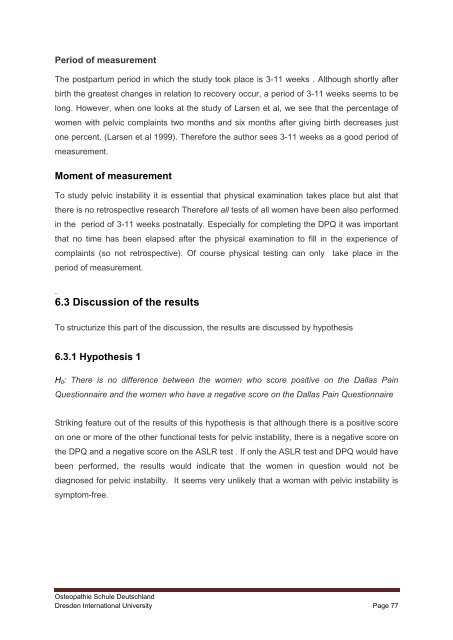Pelvic girdle pain and relevance of ASLR testing: A ... - Cindy Verheul
Pelvic girdle pain and relevance of ASLR testing: A ... - Cindy Verheul
Pelvic girdle pain and relevance of ASLR testing: A ... - Cindy Verheul
Create successful ePaper yourself
Turn your PDF publications into a flip-book with our unique Google optimized e-Paper software.
Period <strong>of</strong> measurement<br />
The postpartum period in which the study took place is 3-11 weeks . Although shortly after<br />
birth the greatest changes in relation to recovery occur, a period <strong>of</strong> 3-11 weeks seems to be<br />
long. However, when one looks at the study <strong>of</strong> Larsen et al, we see that the percentage <strong>of</strong><br />
women with pelvic complaints two months <strong>and</strong> six months after giving birth decreases just<br />
one percent. (Larsen et al 1999). Therefore the author sees 3-11 weeks as a good period <strong>of</strong><br />
measurement.<br />
Moment <strong>of</strong> measurement<br />
To study pelvic instability it is essential that physical examination takes place but alst that<br />
there is no retrospective research Therefore all tests <strong>of</strong> all women have been also performed<br />
in the period <strong>of</strong> 3-11 weeks postnatally. Especially for completing the DPQ it was important<br />
that no time has been elapsed after the physical examination to fill in the experience <strong>of</strong><br />
complaints (so not retrospective). Of course physical <strong>testing</strong> can only take place in the<br />
period <strong>of</strong> measurement.<br />
.<br />
6.3 Discussion <strong>of</strong> the results<br />
To structurize this part <strong>of</strong> the discussion, the results are discussed by hypothesis<br />
6.3.1 Hypothesis 1<br />
H0: There is no difference between the women who score positive on the Dallas Pain<br />
Questionnaire <strong>and</strong> the women who have a negative score on the Dallas Pain Questionnaire<br />
Striking feature out <strong>of</strong> the results <strong>of</strong> this hypothesis is that although there is a positive score<br />
on one or more <strong>of</strong> the other functional tests for pelvic instability, there is a negative score on<br />
the DPQ <strong>and</strong> a negative score on the <strong>ASLR</strong> test . If only the <strong>ASLR</strong> test <strong>and</strong> DPQ would have<br />
been performed, the results would indicate that the women in question would not be<br />
diagnosed for pelvic instabilty. It seems very unlikely that a woman with pelvic instability is<br />
symptom-free.<br />
Osteopathie Schule Deutschl<strong>and</strong><br />
Dresden International University Page 77


